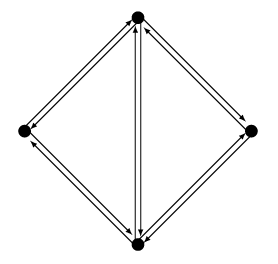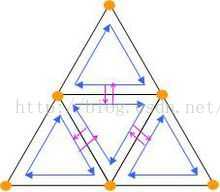怎样遍历网格
介绍
遍历大家都清楚的吧,学习数据结构的时候就经常讲到遍历,比如八叉树中,要遍历每一个节点,有各种遍历方法,什么深度优先遍历,广度优先遍历神马的。在一个网格中,有时候我们也要遍历网格中的每一个点、面、边等基本元,这就是这篇文章的内容。
遍历半边(Halfedge)
首先介绍网格中的半边的遍历,如下图所示的网格拓扑:

根据选择的遍历初始半边的不同,有两种可能的遍历过程:
1. 如果选择的半边落在网格边界上,及不与任意边相邻,通过使用函数
next_halfedge_handle() 或
prev_halfedge_handle(),遍历就会沿着网格的边界(洞)进行;

2. 如果选择的半边与一个面相邻,那么通过使用上面相同的函数,遍历会沿着所有与这个面相邻的半边进行遍历。

当然无论是上面的哪种方式遍历,其实都差不多如下:
[...]
TriMesh::HalfedgeHandle heh, heh_init;
// Get the halfedge handle assigned to vertex[0]
heh = heh_init = mesh.halfedge_handle(vertex[0].handle());
// heh now holds the handle to the initial halfedge.
// We now get further on the boundary by requesting
// the next halfedge adjacent to the vertex heh
// points to...
heh = mesh.next_halfedge_handle(heh);
// We can do this as often as we want:
while(heh != heh_init) {
heh = mesh.next_halfedge_handle(heh);
}
[...]网格边界
从上一节可以发现,遍历网格边界比较简单,那么我们什么时候知道我们所选择的半边是属于一个边界(洞)的呢。在OpenMesh中提供了点、边界、面的边界属性,通过使用is_boundary()函数,返回点、边界(半边)、面是否是一个边界。
注意
从上一节我们知道,只要我们选择的第一条半边是属于一个边界的话,那么它的下一条半边依然会是属于边界的。
所以对于每一种基本元,我们可以如下使用返回边界属性的函数:
// Test if a halfedge lies at a boundary (is not adjacent to a face)
bool is_boundary (HalfedgeHandle _heh) const
// Test if an edge lies at a boundary
bool is_boundary (EdgeHandle _eh) const
// Test if a vertex is adjacent to a boundary edge
bool is_boundary (VertexHandle _vh) const
// Test if a face has at least one adjacent boundary edge.
// If _check_vertex=true, this function also tests if at least one
// of the adjacent vertices is a boundary vertex
bool is_boundary (FaceHandle _fh, bool _check_vertex=false) const向内或者向外的半边
OpenMesh提供了2个用来遍历某一个点的所有向内或者向外的半边的函数VertexIHalfedgeIter 和 VertexOHalfedgeIter。如下图,假设我们选择的是最下面的点,那么VertexIHalfedgeIter就会遍历所有的向内半边(蓝色),而VertexOHalfedgeIter就会遍历所有的向外半边(红色)。

相应的代码类似如下:
[...]
// Get some vertex handle
PolyMesh::VertexHandle v = ...;
for(PolyMesh::VertexIHalfedgeIter vih_it = mesh.vih_iter(v); vih_it; ++vih_it) {
// Iterate over all incoming halfedges...
}
for(PolyMesh::VertexOHalfedgeIter voh_it = mesh.voh_iter(v); voh_it; ++voh_it) {
// Iterate over all outgoing halfedges...
}
[...]反向半边
在半边数据结构中,每一条边都被拆分成了两条方向相反的半边,所以对于每一条半边,存在着对应的反向半边。在OpenMesh中可以通过函数opposite_halfedge_handle()得到某一条半边的反向半边。
例子代码类似如下:
// Get the halfedge handle of i.e. the halfedge
// that is associated to the first vertex
// of our set of vertices
PolyMesh::HalfedgeHandle heh = mesh.halfedge_handle(*(mesh.vertices_begin()));
// Now get the handle of its opposing halfedge
PolyMesh::HalfedgeHandle opposite_heh = mesh.opposite_halfedge_handle(heh);当然除了反向半边之外,OpenMesh中还提供了一下的函数得到一个元的相反元:
// Get the face adjacent to the opposite halfedge
OpenMesh::PolyConnectivity::opposite_face_handle();
// Get the handle to the opposite halfedge
OpenMesh::Concepts::KernelT::opposite_halfedge_handle();
// Get the opposite vertex to the opposite halfedge
OpenMesh::TriConnectivity::opposite_he_opposite_vh();
// Get the vertex assigned to the opposite halfedge
OpenMesh::TriConnectivity::opposite_vh();得到起点和终点
这部分最简单了,就是给定一个半边,因为半边是有方向的,所以肯定有一个起点和一个终点,OpenMesh中起点和终点可以通过如下两个函数得到:
// Get the handle of the to vertex
OpenMesh::Concepts::KernelT::to_vertex_handle();
// Get the handle of the from vertex
OpenMesh::Concepts::KernelT::from_vertex_handle();









![[转]我国CAD软件产业亟待研究现状采取对策-卡核](https://www.caxkernel.com/wp-content/uploads/2024/07/frc-f080b20a9340c1a89c731029cb163f6a-212x300.png)




